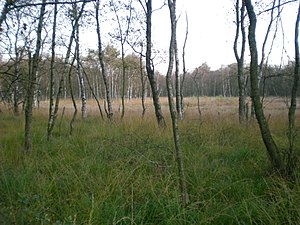Duvenstedter Brook nature reserve
|
Duvenstedter Brook nature reserve
|
||
|
The moorland in Brook, to the side of the approach from the north |
||
| location | Hamburg , Germany | |
| surface | 7.85 km² | |
| WDPA ID | 4383 | |
| Geographical location | 53 ° 43 ' N , 10 ° 10' E | |
|
|
||
| Setup date | 1958 | |
| administration | BUE | |
The Duvenstedter Brook nature reserve is located in the extreme northeast of Hamburg in the area of the Wohldorf-Ohlstedt district and is congruent with the FFH area of the same name and the EU bird sanctuary of the same name .
On an area of 785 hectares , it was placed under protection in 1958, the middle section in 1939. Today, together with the nature reserves Wohldorfer Wald , Ammersbek-Hunnau and Klein-Hansdorfer Brook in the municipality of Jersbek , Stormarn district, it forms a complex of Germany-wide importance with the - after the opening of a red deer gate after the Second World War - the strongest deer in Germany.
Conservation of nature, flora and fauna
In the late 1970s began with a rewetting of peatlands and in 1980 hatched there, the first cranes . Since then there has been a voluntary crane watch every spring. Since 1987 there has also been a colony of ground-breeding gray herons in Duvenstedter Brook . An autumn visitor attraction is the red deer rut in September . The fallow deer rutting follows in October / November . Special screens are set up to ensure that the animals are not disturbed by observation.
At other animal species, among others, are moors and tree frog , badger and raccoon dog , woodcock and snipe , Krick- and Goldeneye and marsh harrier represented, hares and wild boars anyway. Honey buzzard and crane are breeding birds here , and guests can also see sea eagles , ospreys and black storks .
During migration, the area is a stopover, for example for gray geese and cranes.
Of the plants growing in the brook , sundew , orchids such as spotted orchid and two-leaved forest hyacinth as well as a small population of chess flowers belong to the Red List species . Also striking are the abundantly blooming stocks of water crowfoot and water feather in the pools.
geology
Duvenstedter Brook was created during the Vistula Ice Age through an ice reservoir in which silt and fine sands were deposited, some of which alternated with boulder clay or marl . Later, an outflow was created over the Ammersbek into the Alstertal.
history
The brook was used for several centuries by farmers in the villages of Duvenstedt and Lemsahl-Mellingstedt as pasture and for cutting peat. At the end of the 17th century , the Tangstedt chancellery acquired commercial rights of use, which were replaced by 1887. At that time, the Brook was the preferred hunting area of the Wellingsbüttel landowners, the Jauch family , who leased it to their land and released the pheasants that still live in Brook and its surroundings. In 1925 Hamburg bought large parts of the Brookes, which at that time was still in the Stormarn district. The rest came to the Hanseatic city with the Greater Hamburg Law in 1937. In a large, fenced-in part of the area in the 1930s that made NS - Gauleiter Karl Kaufmann , who lived in Duvenstedter Brook, for his private hunting deer from the Carpathian introduce.
Individual evidence
- ↑ 2226303 Duvenstedter Brook. (FFH area) Profiles of the Natura 2000 areas. Published by the Federal Agency for Nature Conservation . Retrieved February 20, 2016.
- ↑ Geotope description "Duvenstedter Brook" of the Geological State Office Hamburg ( Memento of the original from July 29, 2012 in the Internet Archive ) Info: The archive link was inserted automatically and has not yet been checked. Please check the original and archive link according to the instructions and then remove this notice.
- ↑ Jens-Peter Stödter: How the pheasant got into the brook ... and what Günther Jauch has to do with it, in: Naturschutz für die Walddörfer, Annual Report 2013, pp. 84–85
literature
- Hans Walden: Investigations into the history of Duvenstedter Brooks , Hamburg 1987.



